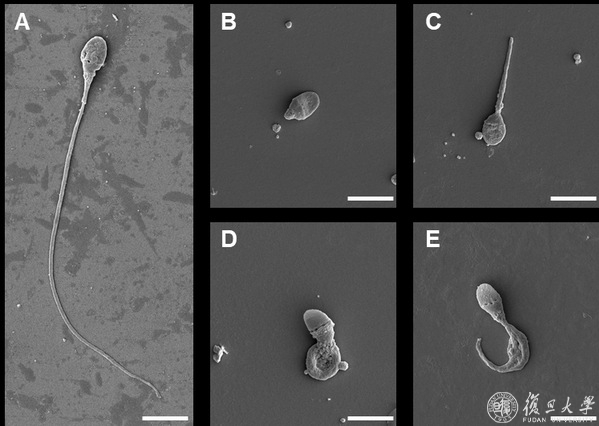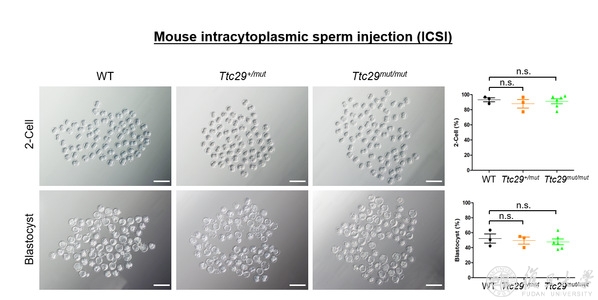Male infertility is a major problem for human reproduction. There are 50 million sub-fertile couples in the world, 30%-55% of whom suffer male infertility. Among various factors that cause male infertility, suboptimal semen quality has attracted growing attention. Based on semen parameters, the diagnosis of male infertility remains limited by the descriptive classification of the sperm parameters, such as asthenozoospermia, teratospermia, etc., but the causes behind are often complex and diverse.
Prof. Zhang Feng from Obstetrics & Gynecology Hospital of Fudan University and Prof. Cao Yunxia from Anhui Medical University have found that TTC29 mutations are a cause of asthenoteratospermia. Their research was published in The American Journal of Human Genetics on Nov. 14.

Figure 1. Normal Sperms(A) and Sperms with TTC29 mutations(B-E)
Sperm is a kind of reproductive cells peculiar to males. Sperm cells are produced inside the seminiferous tubules of the male testicles via meiotic division and chromatin condensation. After growing a tail, they are released from nurse cells into the epididymis where they finish maturing. Its tail (called flagellum) propels sperm for swimming through the vagina, cervical canal and uterus before the sperm fuses with an egg cell in the ampulla of the fallopian tube during fertilization. Therefore, the shape and vigor of sperm are important to the process. Asthenoteratospermia, as a common cause of male subfertility, has already been proved by other researchers as highly relevant to genetic mutation.

Figure 2. Ultrastructure of normal sperms (i, iv) and sperms with TTC29 mutations (ii, iii, v, vi)
Zhang’s team has been devoted to studying the mutations and pathogenesis of asthenoteratospermia. Whole-exome sequencing data analysis has allowed rapid identification of a dozen of genes that account for the disease. In their recent study, they have identified another 3 unrelated cases of TTC29 bi-allelic mutations (3.75%) from a cohort of 80 MMAF-affected Han Chinese men. The abnormalities of sperm morphology (Figure 1) and flagellar ultrastructure (Figure 2) are detected in patients harboring TTC29 mutations. In addition, researchers generated a Ttc29-mutated mouse model through the use of CRISPR-Cas9 technology. Remarkably, Ttc29-mutated male mice also presented reduced sperm motility, abnormal flagellar ultrastructure, which suggests male subfertility bi-allelic mutations in TTC29, as an important genetic pathogeny, can induce MMAF-related asthenoteratospermia.

Figure 3. Outcomes of ICSI in Ttc29-mutated male mice
It’s reported that intracytoplasmic sperm injection (ICSI)-based in vitro fertilization enables males with asthenoteratospermia to have their biological children. Yet previous research shows that chances of success differ among patients carrying different mutations, which explains why relevant studies are so important.
Researchers conduct ICSI experiments on the genetically-edited sperm of Ttc29-mutated mice. It turns out that the two-cell rate and blastocyst rate of Ttc29-mutated mice are almost identical with those of the wild-type (WT) mice (Figure 3). Coincidentally, all of the three men harboring TTC29 mutations underwent ICSI with their own sperm acquired satisfactory outcomes. Therefore, the study also provided effective guidance for molecular diagnosis, genetic counseling and clinical interventions of male subfertility.
Liu Chunyu, Liu Wangjie, Wang Lingbo from Obstetrics & Gynecology Hospital of Fudan University, He Xiaojin from the First Affiliated Hospital of Anhui Medical University and Yang Shenmin from Suzhou Municiple Hospital are the co-first authors. The team, led by researcher Li Jinsong from Shanghai’s Institute of Biochemistry and Cell Biology, CAS and Center of Crye-Electron Microscopy, Zhejiang University have provided technical support.





